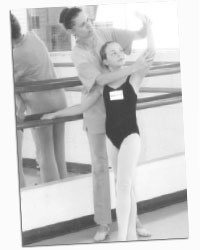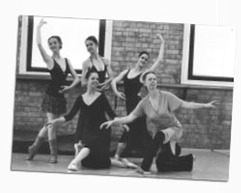Teaching Methodology Robyn Klaus

People often speak of technique and artistic quality as two separate and unrelated concepts. I believe they belong together. A dancer may feel they can express a lot but without a framework or the “corset” of good technique, their expressive dancing will very likely just look amateur. Conversely, a dancer may be able to do many pirouettes, jumps and fashionable “tricks” but if these steps are poorly linked, if the dancing is not harmonious and smoothly co-coordinated, their dancing will have more to do with sport than art. In both cases the problem is more that of emotional disposition than physical limitations. My work as a teacher endeavors to tackle these problems and develop technique and artistic sensibilities simultaneously.
I believe the first step is to create an atmosphere conducive to this in the morning class. It is the first part of any dancers’ daily work where they will train in groups of anything from 15 to 60 dancers at a time. When you walk into the studio as company teacher, the dancers are invariably lying down, stretching and talking amongst themselves; they are tired, some are sore, some injured, some caffeine-deprived and some possibly hung-over. Probably none of them really feel like engaging in the total physical commitment and exertion that is going to be expected of them. Nevertheless your job as teacher is to bring them from this slipshod state to one of energy, focus, productivity and enjoyment - all within 75 to 90 minutes.
Many teachers resort to their own personal energy input and charisma in order to achieve this. They talk in a loud voice and give a running commentary of corrections and/or encouragement. Indeed, in the early days of my dancing career a good teacher was synonymous with these sort of motivational tactics; the class was easily as much about the teacher as it was about the dancers.
Under the influence of George Balanchine and the likes of Stanley Williams in New York however, an alternative, quieter atmosphere was introduced encouraging a focus initiating from the dancers rather than the teacher. Fuelled by the embrace of jazz and contemporary music by choreographers throughout the 20th century, this school of thought also encouraged teachers and dancers to rhythmically train the muscles to the music (previously it was fashionable for ballet pianists to alter the music so as to follow the dancer rather than other way round.) Doubly developing technique and a degree of rhythmical musical sensitivity, this became a most productive way to use the barre to warm up.

The body feels marvelous when worked consistently in this fashion. It is a method that I was fortunate in being able to study for some years and which, with the support of excellent pianists, I have incorporated into my own class. Little time is spent explaining in the first part of the class, the exercises follow in quick succession and need to be rhythmically perfectly calculated. From a teacher’s perspective the added advantage is that the dancers’ concentration is more on the actual class than on the teacher’s personality. Working together on a daily basis the dancers are going to get tired of you, no matter how entertaining or charismatic you may be, so bringing the focus back to them is a good antidote to this.
Even in class, it is easy to see that most dancers tend to work unequally with regard to their technique and artistry. In great dancers however, both aspects are not only well developed but co-dependant and this is the ideal to strive for.
For dancers who are spiritually free with facility of movement but impatient and unclean, you need to find a way to “rein them in”; to have them understand that detail and discipline are very much a part of a mature approach to an art form. This doesn’t mean you have to resort to constant nagging; it can be done with humor and good grace.
On the other end of the spectrum are the dancers who are born perfectionists with natural discipline but have trouble with abandonment in their dancing. They may struggle with interpretation, projection or musical phrasing. In dancers with this particular problem, imagination needs to be encouraged at all times. I think it’s so important for dancers of any age to feel there is no limit to the use of their imagination; it breathes life into the rules and discipline of classical ballet. Imagination also doesn’t need to be treated with much reverence. I find drawing unexpected, even silly analogies with what needs to be achieved is a very effective method of drawing dancers “out of their skin”. For this reason I also feel that associated disciplines such as drama, physical theatre, music and other dance forms are very useful for the dancer’s overall versatility and flexibility of spirit.
You can also develop a dancer’s artistic sensibility from a more technical standpoint. The linking of steps for example, the understanding of the correct transfer of weight, is something that is often neglected by teachers and some teaching systems. It is vital for both harmony of movement, without which it is difficult to have an artistic quality, as well as technical prowess. I am so glad to have been able to study it for some years with Kirov teacher Irene Jacobsen. It is a concept you can use advantageously on all levels, from children onwards and on all physiques, including those not particularly cut out for careers in classical ballet.
Finally, with regard to both technique and artistic development, it is essential that you nurture the dancer’s ability to learn. This means that for clarity’s sake, you need to differentiate between corrections that can be given dogmatically and those that can’t. For example, you can be very firm about righting a sickled foot, hunched shoulders or unmusical dancing; these are universal corrections. There are other pieces of advice you will have gleaned from your own years of personal experience however; these will probably work for some dancers but not for all. Body types and temperaments are so different that while you may have a storehouse of personal tricks that serve you well, it doesn’t mean they should be considered universal revelations in dance technique. I usually qualify these personal directions with “I suggest you try” or “Try this, you may be asked to do it another way, but for now try this way.” Even with younger dancers, this introduces the idea of an unending search, the permanent evolution of dance technique and keeps the concepts of flexibility and ongoing analysis alive. Only a dancer who is analytical and curious can stay on the path of constant development.